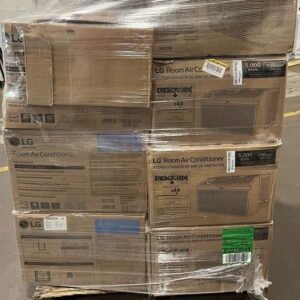Air conditioner pallets
$1,000.00 Original price was: $1,000.00.$720.00Current price is: $720.00.
This pallets contains 9 -12 AC’s
All brand new
Air Conditioner Pallets
As climate change intensifies global temperatures, air conditioning systems have become essential for maintaining comfortable living and working environments. However, the efficiency and longevity of these HVAC (Heating, Ventilation, and Air Conditioning) systems hinge on several factors, one of which is often overlooked: the use of air conditioner pallets. In this article, we delve into the significance of these pallets, their functionality, and best practices for utilization in both residential and commercial settings.
What are Air Conditioner Pallets?
Air conditioner pallets are specially designed platforms used to support air conditioning units, particularly heavy outdoor condensers and package units. These pallets serve several purposes, including providing stability, facilitating drainage, and enhancing airflow. Made from various materials such as plastic, wood, or metal, the choice of pallet largely depends on the installation environment and the specific requirements of the cooling system.
Importance of Air Conditioner Pallets
- Stability and Support: Air conditioning units can be cumbersome and heavy, often weighing several hundred pounds. A pallet serves as a strong foundation, ensuring that the unit is securely positioned and preventing any movement or tilting that could lead to misalignment or damage.
- Drainage: Proper drainage is critical to prevent water accumulation around the air conditioning unit. Pallets are often designed with drainage features that allow water to flow away from the unit, reducing the chances of rust and corrosion and protecting electrical components.
- Airflow Enhancement: Good airflow is essential for the efficient operation of air conditioning systems. By elevating the unit above the ground, pallets allow for unobstructed airflow to the condenser coils. This improved airflow aids in better heat exchange, enhancing the system’s overall efficiency and longevity.
- Protection from Environmental Hazards: Elevated platforms protect the units from debris, dirt, and other environmental hazards. This can be especially important in areas prone to flooding or heavy rainfall, where standing water can lead to critical damage.
- Ease of Maintenance: Installing air conditioning units on pallets can make routine maintenance easier. Climatic and operational factors can lead to the buildup of dirt and debris over time.
Choosing the Right Pallet
When selecting an air conditioner pallet, several factors should be considered:
- Material: Depending on the environment, you may choose between plastic, wood, or metal. Plastic pallets are lightweight and resistant to corrosion, while wooden pallets are sturdy but can absorb moisture, potentially leading to decay. Metal pallets are durable but may conduct heat.
- Size and Weight Capacity: Ensure that the pallet can adequately support the weight of the air conditioner unit. Review manufacturer specifications and compare them to the pallet’s weight capacity to avoid overloading.
- Design Features: Look for pallets that come equipped with built-in drainage systems and ventilation spaces. These features can significantly optimize performance and maintenance.
Installation Best Practices
- Level Ground: Always place pallets on a level surface to prevent strain on the air conditioning unit and ensure proper function.
- Secure Fastening: If the air conditioning unit is being installed in a high-wind area, consider anchoring the pallet to the ground for added stability.
- Regular Inspection: Periodically inspect the pallet for signs of wear or damage, especially after severe weather events. Replace any damaged pallets to maintain the integrity of the cooling system.
- Professional Installation: If unsure about the installation process, consult with HVAC professionals. They can recommend the best pallet solutions for your specific setup and ensure optimal installation.
Be the first to review “Air conditioner pallets” Cancel reply
Related products
Electronics
Electronics
Mixed
Electronics
Electronics
Electronics
Clothing
Electronics

























Reviews
There are no reviews yet.